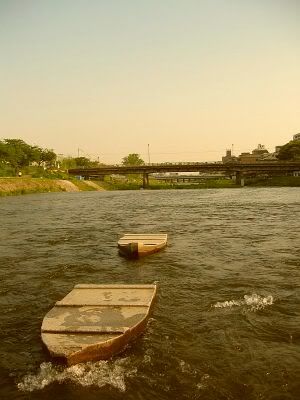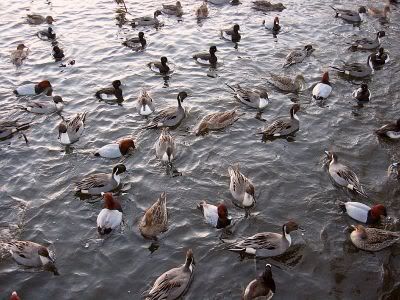
Floods often threatened the ancient capital. Emperor Shirakawa (1053 - 1129) recited his three unmanageable things : armed monks of Enryaku-ji, the roll of the dice and water of the Kamo River.

The merchant Suminokura Ryoi constructed the Takase Canal as a parallel with the Kamo River in early 17th century. Transportation was done in the canal instead of in the unstable mainstream of the river.

Most of the time now, the water level is quite low, and therefore, it is possible to cross to the other side, hopping on the river stone steps put there for such purpose. These stone steps bring people closer contact with the river.

In a great flood, the river ran amok in 1935 and destroyed 32 of the 41 bridges. Under some of the reconstructed bridges are now occupied by some homeless men. They keep everything clean, catch fishes from the river and never bother anyone.

The route of the river is highly linear. The river banks are popular walks for residents and tourists especially during the cherry blossom festival (topmost picture).

During the Children's Day (kodomo no hi), a string of koinobori-like was tied across the Kamo River.

Wildlife has found a way along the Kamo River. Seen here is a heron.

A group of wild kamo ducks were spotted swimming about in the river.

The riverbank is a popular place for young couples to sit together. It is also very common for one to bring a bento (lunch box) and eat by the river side. Kamo River is recognized as the city's treasure.

15 comments:
WOW...
the country side scene is great
the stepping stones a bit scarry though...
love the pic with the stone pathway with grasses and little yellow flowers...
nice...
lovely...looks clean and refreshing...
hmmmm.... malaysia never have anything like this...
if it does, then it is not that easily accessible...sad case
You have a lot of talent with a camera. I really enjoyed your photos!
The KAmo river looks pretty calm in ur photo :) Oh yah, the river is named after those wild ducks? Any story bout it?
Wah...can go there for honeymoon liao. By the way, is the night view there beautiful??
zbjernak : this is no country side. it is in the city. some of these pics are taken by my thai friend (i.e. the stone pathway with grass and little yellow flowers). i like it as well. i dont remember KL as beautiful as kyoto. perhaps, the next time when i am back home for holidays, i shall take as many pics as possible. but usually i always end up staying indoor because too hot outside. and always addicted to astro programs.
hanka : thanks for your comment. will take and upload more pictures in the future.
acrix : yes, i think the river is named after the wild ducks, kamo. stories ? aiks ... should have but i dont know wor. i asked a few of my dorm mates, they dont know as well. i will ask my host mum this saturday when she comes to my dorm for food festival. but i dont think she knows as well because last time i asked her about the torii (the question that you asked in the comment) and other questions related to the shrine, she frowned abit. because of difficult questions. i think if we analyze the kanji (chinese-like characters) of the word kamo, we can relate a story and the reason 'kamo' being the name of the river. but, the problem is i dont read kanji well. i am from 'kebangsaan' school. this morning fish fish was sort of teasing me. i couldnt write 京都国際学生の家 when i tried to explain to her where i live. she grabbed the pen from me and helped herself.
emotionalistic : honeymoon ? wah .. congratulations. getting married soon ? night view ? most part of the river is dark at night. the area in sanjyo and shijyo is beautiful. i will do a posting of it next week.
p de animal : are you from thailand ? i guess you often hang out with eddie, chan and ailing ? ok, lets meet some time. movies, karaoke, food, sightseeing ...
Hmm, so what is the river mainly used for?
Lovely place to stroll all year round... and to watch lovers smooching by the river side... also, quite a few homeless people living in card board houses under the bridges...
No lah....where got so fast. Just graduated, want to marry already meh?? Must get a job first :). Looking forward for next week then ;).
primrose : it is difficult to write the history of a river unless one really digs into it. sorry for being lazy. just obtained abit of information from the net (perhaps might clear your doubt). according to japanese history, kamo river is the main river in the ancient capital. it was a source of water for the farmers. weirs and irrigation channels were constructed in order to get enough water from the river for rice planting.
presently, the kamo river is a beautiful part of the city. however during the Shinran's time, disease once spread through the city, killing thousands of people. not sure how true it is but it was mentioned that the river was lined with the corpses of the dead that time.
lrong : yes. i forgot to mention that part - lovers smooching by the river side. you and your missus been there too ?
emotionalistic : ok. good luck in job hunting. :P
*gasp* Lined with corpse??
Wah...really romantic place to stroll with cherry blossom, love ducks, clear river.....
Nice photos, made nicer with all the comments. Especially Lrong and his version of smooching. Hahaha.
The bridge look a bit old, when it was built actually?
why are those boats on the middle of the river.
It looks like made of stone or cements.
What is that?
What is the purpose?
primrose : throwing dead bodies into the river is not uncommon especially following a massacre or some sort of grueling fights between clans. not sure how accurate with regards to the dead bodies thrown into the kamo river. i have never heard about it until i read in an article posted in internet. on the other hand, i have also read that in Hiroshima, when the atomic bomb exploded, thousands of badly burned residents threw themselves into the river to ease the pain. many of them didn't survive, so there were hundreds of corpses in the river. check post : remembering hiroshima (archive 01/09/2005 - 01/15/2005). ok, enough about dead bodies for the time being.
5xmom : we often cycle along the river banks on our way to sanjyo or shijyo for shopping. the river scenery is beautiful - blissful.
mrkiasu : yes, some of the bridges are indeed really old. when they were built ? i am not sure. in the 30s, 40s or 50s perhaps. i dont know. many of them are reconstructed. in the past, i guess they were wooden bridges. several big floods destroyed many of them.
mengz : those stones are put there to make possible for one to cross to the other side of the river. some have the shape of a boat, others turtle and mostly square stones. it is not scary. most of the time the water level is quite low (not on rainy seasons though). sometimes it is really pleasant to sit on these stones and dip your feet into the river water.
Patrick,
Stumbled upon your blog when reading mrkiasu.com. Just read your main page and must say that Japan is truly a beautiful country.
Looking forward to digging into your archives and discovering more on Japan. Also looking forward to more updates from you. Cheers!
-Makan Kings-
Post a Comment